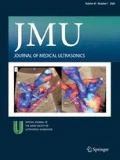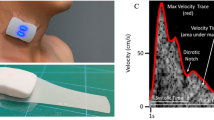Abstract
Purpose
Automatic Doppler flow signal detection systems can provide beat-to-beat information for large blood vessels. We have developed new equipment for automatic measurement of Doppler flow signals. The reliability of the system was examined, and the variability of aortic and pulmonary peak flow velocity was determined.
Methods
We measured peak flow velocity using a newly developed system in healthy volunteers and patients with atrial fibrillation. Analysis of variability of peak flow velocity was performed with maximal entropy methods.
Results
In Bland–Altman plots, the mean and standard deviation (SD) of differences in aortic peak flow velocities between the automatic and manual measurements were 0.22 ± 0.75 cm/s and 0.85 ± 0.38 cm/s, respectively, in five normal volunteers. Moreover, less than 5% of the plotted points were beyond ± 2 SD of the differences. Furthermore, good reproducibility was demonstrated using Bland–Altman plots and Pearson's correlation analysis. Identical reliability was obtained in patients with atrial fibrillation. The same results were obtained for pulmonary peak flow velocity. In five healthy subjects, aortic and pulmonary peak flow showed standard deviations of 7.2 ± 2.4 and 3.8 ± 0.6 cm/s, respectively, and coefficients of variation of 6.1% ± 1.0% and 5.1% ± 1.1%, respectively, in time-domain variability. Similarly, frequency-domain variability was obtained for both peak flow velocities.
Conclusion
The present study demonstrated the reliability of a newly developed automatic Doppler flow signal detection system. Using this system, the present study demonstrated for the first time aortic and pulmonary peak flow velocity variability. The present analytical methods may have considerable potential for studying aortic and/or pulmonary flow variability in connection with cardiac performance and prognosis of cardiac disease.
Similar content being viewed by others
References
F Kusumoto T Venet NB Schiller et al. (1995) ArticleTitleMeasurement of aortic blood flow by Doppler echocardiography: temporal, technician, and reader variability in normal subjects and the application of generalizability theory in clinical research J Am Soc Echocardiogr 8 647–53 Occurrence Handle9417207 Occurrence Handle10.1016/S0894-7317(05)80378-5 Occurrence Handle1:STN:280:DyaK287hs1CmtA%3D%3D
InstitutionalAuthorNameWorld Medical Association (2000) ArticleTitleDeclaration of Helsinki. Ethical principles for medical research involving human subjects JAMA 284 3043–5 Occurrence Handle10.1001/jama.284.23.3043
K Otsuka T Yamanaka Y Kubo et al. (1993) ArticleTitleChronobiology in cardiology Ann Ist Super Sanita 29 633–46 Occurrence Handle7985926 Occurrence Handle1:STN:280:DyaK2M%2FnslantQ%3D%3D
Y Sawada N Ohtomo Y Tanaka et al. (1997) ArticleTitleNew technique for time series analysis combining the maximum entropy method and non-linear least squares method: its value in heart rate variability analysis Med Biol Eng Comput 35 318–22 Occurrence Handle9327605 Occurrence Handle10.1007/BF02534083 Occurrence Handle1:STN:280:DyaK2svmvVGiug%3D%3D
JM Bland DG Altman (1986) ArticleTitleStatistical methods for assessing agreement between two methods of clinical measurement Lancet 1 307–10 Occurrence Handle2868172 Occurrence Handle1:STN:280:DyaL287hslWqsQ%3D%3D
JM Bland DG Altman (1999) ArticleTitleMeasuring agreement in method comparison studies Stat Methods Med Res 8 135–60 Occurrence Handle10501650 Occurrence Handle10.1191/096228099673819272 Occurrence Handle1:STN:280:DyaK1MvivFOmug%3D%3D
L Moulinier T Venet NB Schiller et al. (1991) ArticleTitleMeasurement of aortic blood flow by Doppler echocardiography: day to day variability in normal subjects and applicability in clinical research J Am Coll Cardiol 17 1326–33 Occurrence Handle2016450 Occurrence Handle1:STN:280:DyaK3M3gtFKmtA%3D%3D Occurrence Handle10.1016/S0735-1097(10)80143-3
K Otsuka S Murakami Y Kubo et al. (2003) ArticleTitleChronomics for chronoastrobiology with immediate spin-offs for life quality and longevity Biomed Pharmacother 57 IssueIDsuppl 1 1s–18s Occurrence Handle14572671 Occurrence Handle10.1016/j.biopha.2003.08.018
Author information
Authors and Affiliations
Corresponding author
About this article
Cite this article
Morita, C., Nakatsu, T., Kusachi, S. et al. Development of an automatic Doppler flow signal detection system: variability of pulmonary and aortic peak flow velocity. J Med Ultrasonics 34, 37–42 (2007). https://doi.org/10.1007/s10396-006-0126-7
Received:
Accepted:
Published:
Issue Date:
DOI: https://doi.org/10.1007/s10396-006-0126-7




